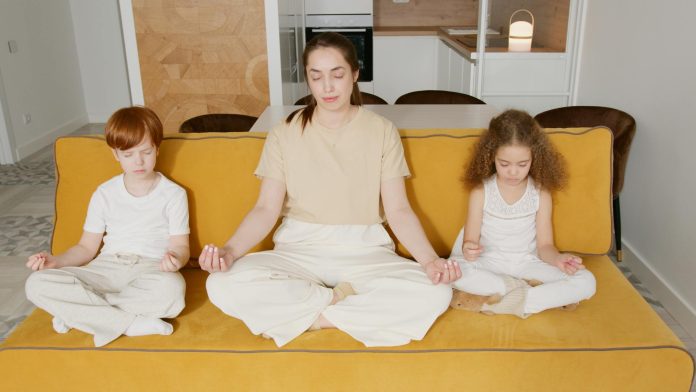In the hustle and bustle of modern life, finding time to connect as a family can be challenging. Amidst work, school, extracurricular activities, and digital distractions, it’s easy to feel disconnected and stressed. Family meditation offers a powerful way to bring mindfulness into your home, fostering deeper connections and creating a sense of calm. This guide explores the benefits of family meditation and provides practical tips for incorporating shared mindfulness into your daily routine.
The Benefits of Family Meditation
Meditation is often thought of as a solitary practice, but its benefits can be amplified when done together as a family. Engaging in mindfulness activities as a family can improve communication, reduce stress, and build emotional resilience. For children, meditation can enhance focus, reduce anxiety, and promote better sleep. For adults, it can provide a much-needed respite from the pressures of daily life, fostering a sense of inner peace and clarity.
One of the key benefits of family meditation is the opportunity it provides for connection. In a world where families are often pulled in different directions, setting aside time to meditate together can create a shared experience that strengthens familial bonds. It encourages open communication and emotional expression, helping family members understand and support one another better.
Additionally, family meditation can serve as a valuable tool for managing stress. Mindfulness practices teach individuals how to remain present and calm, even in challenging situations. This can be particularly beneficial for children and teens, who are still developing their coping skills. By practicing meditation together, families can create a supportive environment where everyone learns to manage stress in healthy ways.
Getting Started with Family Meditation
Starting a family meditation practice doesn’t have to be complicated. The first step is to create a conducive environment for mindfulness. Choose a quiet, comfortable space in your home where everyone can sit together without distractions. It could be a corner of the living room, a dedicated meditation room, or even a spot in the backyard. Ensure that the space is free from electronic devices and other interruptions.
Begin with short, simple sessions to introduce the concept of meditation to your family. For younger children, start with five-minute sessions and gradually increase the duration as they become more comfortable with the practice. Explain the purpose of meditation in a way that’s easy for them to understand, focusing on the idea of being present and calm.
One effective way to start is with guided meditations. There are numerous apps and online resources that offer family-friendly guided meditations, which can make the process more engaging and accessible. Guided meditations can provide structure and help everyone stay focused, particularly if they are new to the practice.
Techniques for Family Meditation
There are several meditation techniques that are well-suited for family practice. One popular method is deep breathing exercises. Teach your family to take slow, deep breaths, inhaling through the nose and exhaling through the mouth. This simple technique can quickly reduce stress and bring a sense of calm. To make it more engaging for children, you can incorporate visualizations, such as imagining blowing up a balloon with each inhale and letting it float away with each exhale.
Another effective technique is body scan meditation. This involves focusing attention on different parts of the body, starting from the toes and moving up to the head. Encourage each family member to notice any sensations they feel in each part of the body, without judgment. This practice can help everyone become more aware of their physical presence and release tension.
Gratitude meditation is also a wonderful practice to share as a family. Sit together and take turns expressing things you are grateful for. This can be done silently or out loud, depending on your family’s preference. Focusing on gratitude can shift the collective mindset from stress and negativity to appreciation and positivity.
Mindful listening is another technique that can strengthen family bonds. In this practice, one person speaks about their day or a particular topic, while the rest of the family listens mindfully, without interrupting. After the person finishes, others can share their reflections or simply express support. This practice enhances communication skills and fosters empathy within the family.
Incorporating Meditation into Daily Life
To make meditation a regular part of your family’s routine, try incorporating it into daily activities. For example, you can start or end the day with a brief meditation session. Morning meditations can set a positive tone for the day, while evening sessions can help everyone unwind and prepare for a restful night’s sleep.
Incorporate mindfulness into everyday tasks. Practice mindful eating by focusing on the taste, texture, and smell of your food during meals. Encourage your family to take mindful walks, paying attention to the sights, sounds, and sensations of nature. These simple practices can reinforce the principles of mindfulness and make them a natural part of your family’s lifestyle.
It’s also important to be flexible and patient. Not every session will go perfectly, and that’s okay. The goal is to create a consistent practice that everyone looks forward to, rather than a rigid routine that feels like a chore. Allow each family member to express their preferences and make adjustments as needed to ensure that the practice remains enjoyable and beneficial for everyone.
Family meditation is a powerful tool for fostering connection, reducing stress, and promoting overall well-being. By introducing mindfulness practices into your family’s routine, you can create a shared experience that strengthens your bonds and supports each member’s mental and emotional health. Whether through guided meditations, deep breathing exercises, or gratitude practices, there are numerous ways to make mindfulness a part of your daily life.
Start small, be consistent, and most importantly, enjoy the journey together. As your family embraces meditation, you’ll likely find that the benefits extend far beyond the meditation sessions themselves, leading to a more harmonious and connected home environment. By prioritizing shared mindfulness, you’re investing in the health and happiness of your family for the long term.

